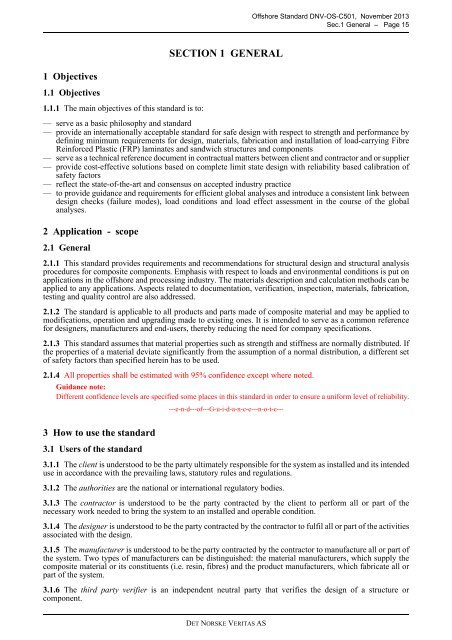OS-C501
You also want an ePaper? Increase the reach of your titles
YUMPU automatically turns print PDFs into web optimized ePapers that Google loves.
Offshore Standard DNV-<strong>OS</strong>-<strong>C501</strong>, November 2013<br />
Sec.1 General – Page 15<br />
SECTION 1 GENERAL<br />
1 Objectives<br />
1.1 Objectives<br />
1.1.1 The main objectives of this standard is to:<br />
— serve as a basic philosophy and standard<br />
— provide an internationally acceptable standard for safe design with respect to strength and performance by<br />
defining minimum requirements for design, materials, fabrication and installation of load-carrying Fibre<br />
Reinforced Plastic (FRP) laminates and sandwich structures and components<br />
— serve as a technical reference document in contractual matters between client and contractor and or supplier<br />
— provide cost-effective solutions based on complete limit state design with reliability based calibration of<br />
safety factors<br />
— reflect the state-of-the-art and consensus on accepted industry practice<br />
— to provide guidance and requirements for efficient global analyses and introduce a consistent link between<br />
design checks (failure modes), load conditions and load effect assessment in the course of the global<br />
analyses.<br />
2 Application - scope<br />
2.1 General<br />
2.1.1 This standard provides requirements and recommendations for structural design and structural analysis<br />
procedures for composite components. Emphasis with respect to loads and environmental conditions is put on<br />
applications in the offshore and processing industry. The materials description and calculation methods can be<br />
applied to any applications. Aspects related to documentation, verification, inspection, materials, fabrication,<br />
testing and quality control are also addressed.<br />
2.1.2 The standard is applicable to all products and parts made of composite material and may be applied to<br />
modifications, operation and upgrading made to existing ones. It is intended to serve as a common reference<br />
for designers, manufacturers and end-users, thereby reducing the need for company specifications.<br />
2.1.3 This standard assumes that material properties such as strength and stiffness are normally distributed. If<br />
the properties of a material deviate significantly from the assumption of a normal distribution, a different set<br />
of safety factors than specified herein has to be used.<br />
2.1.4 All properties shall be estimated with 95% confidence except where noted.<br />
Guidance note:<br />
Different confidence levels are specified some places in this standard in order to ensure a uniform level of reliability.<br />
---e-n-d---of---G-u-i-d-a-n-c-e---n-o-t-e---<br />
3 How to use the standard<br />
3.1 Users of the standard<br />
3.1.1 The client is understood to be the party ultimately responsible for the system as installed and its intended<br />
use in accordance with the prevailing laws, statutory rules and regulations.<br />
3.1.2 The authorities are the national or international regulatory bodies.<br />
3.1.3 The contractor is understood to be the party contracted by the client to perform all or part of the<br />
necessary work needed to bring the system to an installed and operable condition.<br />
3.1.4 The designer is understood to be the party contracted by the contractor to fulfil all or part of the activities<br />
associated with the design.<br />
3.1.5 The manufacturer is understood to be the party contracted by the contractor to manufacture all or part of<br />
the system. Two types of manufacturers can be distinguished: the material manufacturers, which supply the<br />
composite material or its constituents (i.e. resin, fibres) and the product manufacturers, which fabricate all or<br />
part of the system.<br />
3.1.6 The third party verifier is an independent neutral party that verifies the design of a structure or<br />
component.<br />
DET NORSKE VERITAS AS



